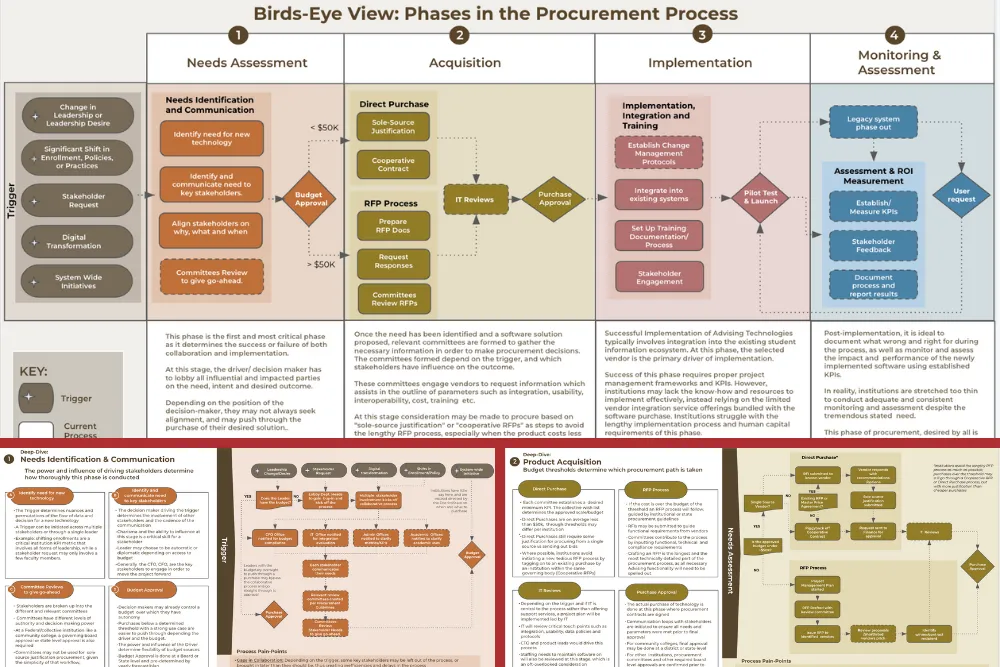Equity-centered solutions are most effective when they are shaped by the voices and experiences of those most affected. As our client, a large education focused foundation, and its partners work to improve student success, co-design becomes a critical tool for ensuring that strategies are not only well-intentioned but truly grounded in the needs of students, families, and institutions. By establishing a shared understanding and consistent methodology for co-design, our client can foster more inclusive, transparent, and impactful collaboration. This helps our client gets closer to its goal of helping ensure that the solutions developed are relevant, responsive, and sustainable in advancing educational equity.
Institutions serving low-income, first-generation, and under-resourced students often face structural challenges that limit their ability to invest and improve their services for their students. Our client, an implementation focused non-profit serving high-pell Institutions, recognized that to sustain and scale its support for these institutions, it needed a more efficient and strategic operational foundation, and a clear, actionable plan for the future. We partnered with our client to co-create a strategy that aligns with its mission and values, ensuring that future growth is not only possible but purpose-driven. By focusing on long-term capacity-building and systemic impact, the work lays the groundwork for our client to reach more institutions and deepen its support and ultimately support their students to have technologies and systems that enhance their ability to succeed.
Paritii partnered with five institutions and the EdTech vendors that support them as part of a consortium dedicated to overcoming obstacles that hinder effective advising solutions in lower-resourced institutions. As a strategic learning partner, Paritii facilitated the assessment of advising challenges, guided the implementation of data-driven interventions, and worked collaboratively to refine technology solutions that enhance student support and success.
To help institutions, program administrators, developers, implementers, and funders evaluate the effectiveness of postsecondary technology solutions, we designed a Responsible Technology Solutions Rubric. This framework assesses how well a technology solution prioritizes fairness in AI, user-centric design, and accessibility for underserved students. It also enables institutions to self-assess their readiness to successfully adopt and integrate new advising solutions in a way that maximizes impact and effectiveness.
To understand the relationships between stakeholders within the software procurement process at Post-Secondary Institutions, we studied the strength of interactions vs the flow of data in Advising software and created a map that helps institutions identify potential gaps in the procurement process.
With the move to Holistic Advising comes even more fragmentation of technology products that help students along their journey. To better understand how technology can enable student success, we interviewed a diverse set of students and advisors to prioritize their use cases and advise institutions on creating a technology procurement roadmap for Advising Software.
In order to create Holistic Advising solutions that enable student success, it is important to ensure that all stakeholders are speaking the same language and have a shared understanding of what this truly means. To facilitate these discussions, we created an Advising Taxonomy that outlines what Holistic Advising means, how it is actualized, who does the advising, and where Advising occurs for students.
The various support systems available to students are critical in enabling their success or failure in their post-secondary education. We created an ecosystem map to understand the human, process, and technological resources students turn to for advice before, during, and after their Post-Secondary journey.
Comprehensive college advising plays a crucial role in supporting students facing barriers to success. We conducted interviews with both students and advisors to gain insights into what effective advising looks like and to identify the most impactful elements at different stages of the student journey. These insights help inform the development of meaningful interventions that enhance academic and personal support.
We created the first blueprint for responsible, digital learning solutions. Our approach integrates fairness in AI, advanced UX/UI analytics, and a product development process like no other. We demonstrate that technology can bridge opportunity gaps and empower all users by removing barriers that hinder progress.
Postsecondary education suffers from a “success gap” where specific student profiles are deemed less likely to succeed. We did a root cause analysis of what causes some students to disproportionately fail, withdraw and not complete. We delivered a blueprint to closing the gap using a whole systems approach to academic and social integration.
There is a fundamental responsibility to create products that serve a broad range of users. However, limitations within the product development value chain can restrict who benefits from innovation. We help our clients expand participation and accessibility, enhancing both their market reach and customer trust while driving sustainable growth.
We addressed gaps in the healthcare system, ensuring monoclonal antibody treatment was accessible to communities in remote and underserved areas during the COVID-19 emergency. Our public health strategy and management approach helped our client expand their presence in regions with limited healthcare access, improving treatment availability for those most in need.
We developed community-responsive COVID-19 vaccine education and programming tailored for low-income communities. Our customized public health initiatives increased vaccine uptake, restored confidence, and contributed to improved community health outcomes. Additionally, we provided guidance to national public health efforts, helping others replicate our success in expanding access and awareness.
